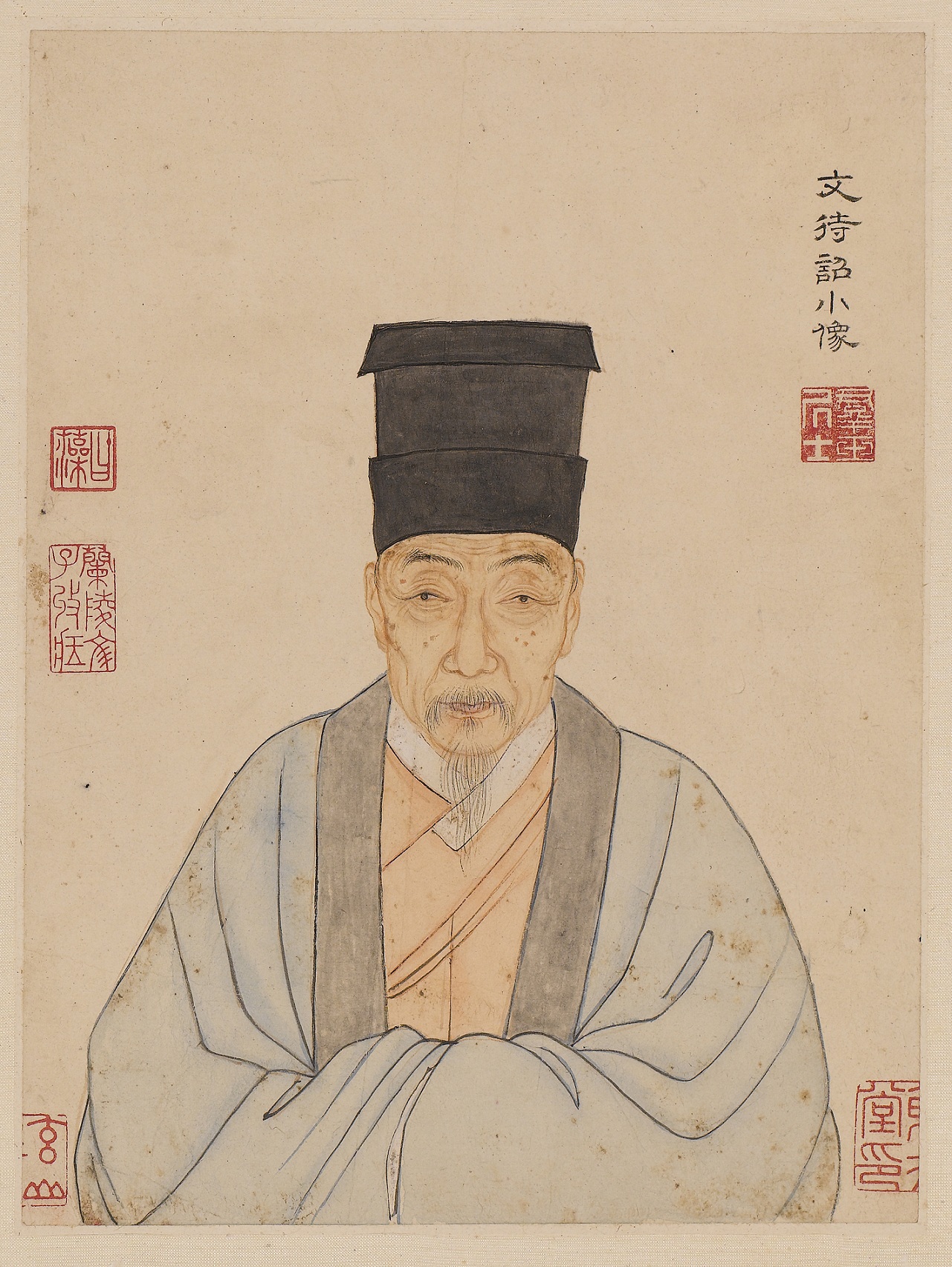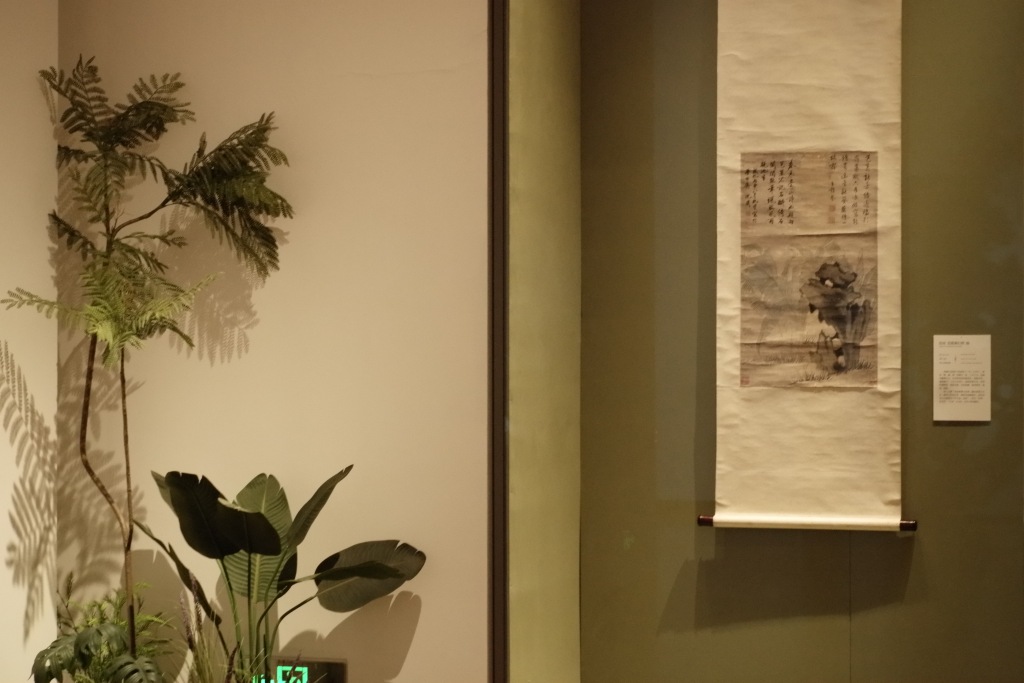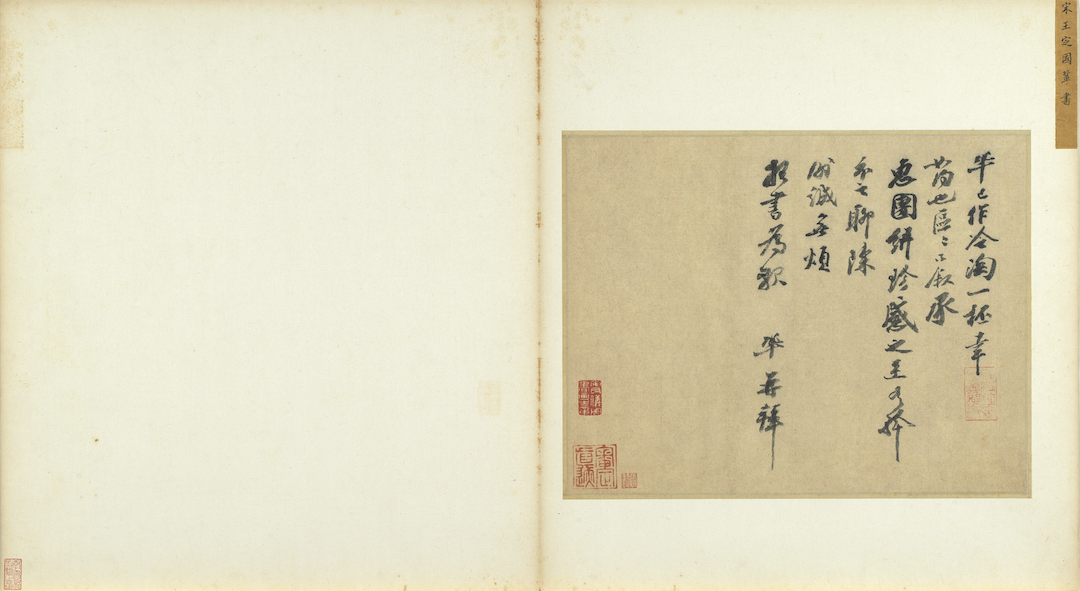
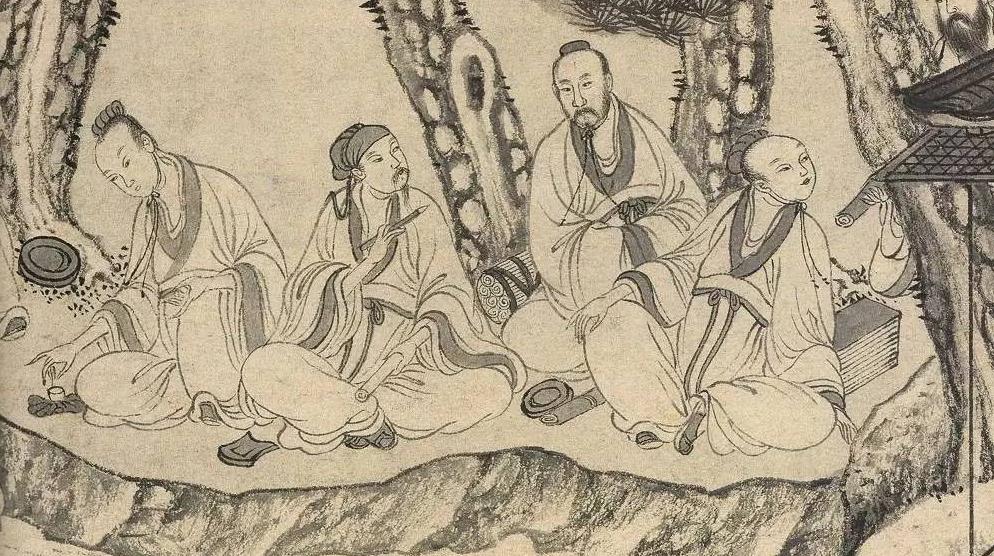
Today is the third day of March, the Shangsi Festival, which is an ancient Chinese traditional festival.
The ancients offered sacrifices to their ancestors every day, which was called "祓禊", Xiu禊, "禊祭", or simply "禊". Since then, it has gradually become a festival for drinking banquets by the water and outings in spring. Wang Xizhi's "Orchid Pavilion Preface" records the collection of the Shangsi Festival in the ninth year of Yonghe. Since then, Shangsi Festival and calligraphy have been integrated into one, and are inseparable from Yaji. Li Gonglin of the Northern Song Dynasty was the first to create the "Lanting Picture", but unfortunately there is no authentic work left in the world. The "Orchid Pavilion Collection Preface Scroll" created by Yu Zizhi, a poet and painter in the Southern Song Dynasty with reference to Li Gonglin's original book, is the earliest "Orchid Pavilion Picture" that can be seen so far.
Many important Chinese festivals are "stacked numbers", such as the first day of the first month, the second day of February, the third day of March, the fifth day of May, the seventh day of July, and the ninth day of September. The third day of March is the Shangsi Festival, which is an ancient traditional festival in China. It was called "Yuansi" in the Zhou Dynasty, which refers to the first Si day in March. Before the Han Dynasty, Si Day was set in the first ten days of March, and after the Wei and Jin Dynasties, it was fixed as March 3rd. On this day, washing dirt by the water and offering sacrifices to ancestors is called 祓禊, repairing 禊, 禊 offering, or simply 禊. Since then, it has gradually become a festival for drinking banquets by the water and outings in spring. The so-called banquet by the water is called "a drink of flowing cups of curved water". The so-called "flowing cup", also known as "flowing cup", is to throw a cup on the upstream of the water, listen to it go down with the waves, stop at a certain place, and the person will take it and drink it. This is what Wang Xizhi wrote in "The Preface to the Lanting Pavilion": "There are lofty mountains, lush forests and bamboos here, as well as clear and turbulent streams, which are reflected on the left and right, leading to the flowing cups and curved waters, and sitting next to each other. Although there is no silk and bamboo orchestra, a cup One chant is enough to narrate the quiet feelings."
Now when it comes to Shangsi, one must first think of Shaoxing Lanting, and even "Lanting Preface", and the resulting elegant collection. All this is due to Wang Xizhi, who endowed the Shangsi Festival with the connotation of calligraphy. From a place name like Lanting, to the publication of the famous "Preface to Lanting", to the research related to "Lanting", it is memorable. After Wang Xizhi, "Lanting Preface" became a widely copied version by folk calligraphy lovers.
I have collected more than 200 pictures of "Preface to the Lanting Pavilion" by famous masters of the past dynasties, which are magnificent. The beginning of the real prosperity should be the four major copies of Feng Chu Ou Yu in the Tang Dynasty. This is of course due to the promotion of Tang Taizong Li Shimin, and this system is never closed, and people are constantly added, such as Zhao Mengfu, Dong Qichang, Wen Zhengming and Wang Duo, etc., repeating it over and over again, never tired of it. Copying "Orchid Pavilion Preface" is not only to acquire techniques, but also a kind of spiritual sustenance and inheritance. Whether the literati and calligraphers of later generations, whether they are calligraphers or literati, whether they worship Wang Xizhi himself, or admire this kind of romantic spirit scattered in his arms, all of them are bound by "Lanting Preface", imitating "Lanting Pavilion", painting "Lanting Pavilion" , Say "Lanting"...

Tang Feng Chengsu's "Orchid Pavilion Preface" (Shenlong Version), Gui Chou Shangsi
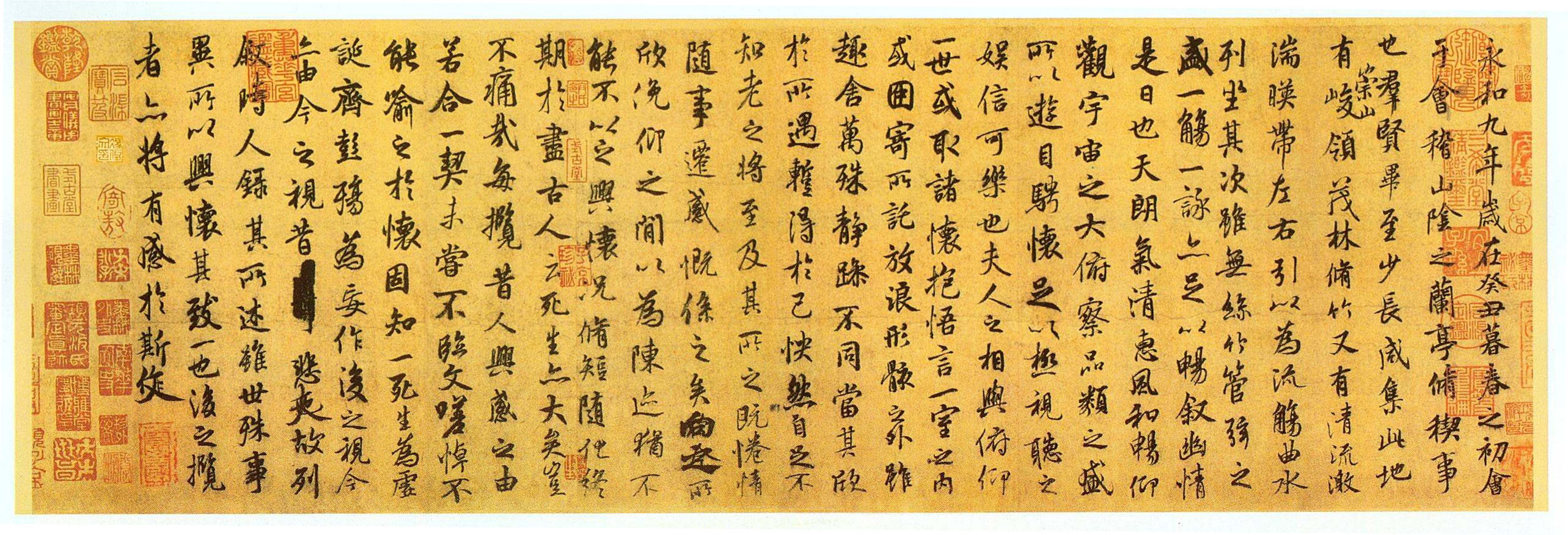
Tang Chu's copy of "Lanting Preface" volume
Feng Chengsu's facsimile is the most famous, known as the "Dragon Version". The word "Shenlong" just witnesses the characteristics of Chinese culture. Wang Xizhi is regarded as a "sage of calligraphy", but none of his authentic works have been handed down to the world. It can be said that "the dragon sees the head but does not see the tail". Except for this copy of "Orchid Pavilion Preface", Feng Chengsu has no authentic works handed down to the world, and it also has the characteristics of "spiritual concealment". This book depicts finely, with brushwork, ink, strokes, and verve, all presented one by one. The whole work is completed in one go, with a cohesive breath, natural and smooth brushwork, and the implicated parts are as thin as hair, and the changes are natural without the slightest hesitation or sluggishness. Even "Pofeng" and "Zeihao" are described very delicately, and the rewritten handwriting also shows successive layers, traces of strokes, ink color shades are very clear, and the structure of the frame is also reflected from left to right, oblique, dense, and dense. Patchwork, natural and vivid. Recognized as the best copy, it lives up to its reputation.
"Orchid Pavilion Preface" was originally a "family heirloom" and has been handed down to the seventh Sun Zhiyong. Ouyang Xiu once talked about the whereabouts of the "Lanting Preface" in "Ji Gu Lu": "The real version of Shi Yan was buried in Zhaoling, and it was published by Wen Tao during the chaos at the end of Tang Dynasty. And discard it, so since the Jin and Wei Dynasties, the ink marks of the sages have returned to the world." The main meaning is that the "Lanting Preface" may not be in Zhaoling, but may have passed away forever. However, in the thousands of years since then, the world is still full of interest in the traces of "Lanting Preface". Tang Taizong loved Wang Xizhi's calligraphy very much, and felt very regretful that he could not get "Lanting Preface". Fang Xuanling recommended the great-grandson of Emperor Liang Yuan, and Xiao Yi, the talented and resourceful supervisory censor, tricked Zhiyong's disciple Biancai into obtaining the "Lanting Preface". "Xiao Yi Earning the Orchid Pavilion" painted by Yan Liben is like a reappearance of the scene. The word "earning" makes people feel a lot of emotion. While appreciating superb techniques and classical artistic conception, it also has a modern plot. "koan".

Tang Yan Li's original painting "Xiao Yi earns the Orchid Pavilion" (see the end of the article for the vertical picture)
Li Gonglin of the Northern Song Dynasty was the first to create the "Lanting Picture", but unfortunately there is no authentic work left in the world. What I see now is Zhao Boju's work, which is a false entrustment. The "Orchid Pavilion Collection Preface Scroll" created by Yu Zizhi, a poet and painter in the Southern Song Dynasty with reference to Li Gonglin's original book, is the earliest "Orchid Pavilion Picture" that can be seen so far. Since then, almost all the "Orchid Pavilion Xiuqitu" have come out in the past dynasties, forming the "Painting Orchid Pavilion" series.

Yu Zizhi of the Southern Song Dynasty "The Preface to the Lanting Collection" (see the end of the article for the vertical picture)
Yu Zizhi's "Orchid Pavilion Collection Preface Picture Volume" draws a panorama of Lanting activities. Forty-two literati headed by Wang Xizhi sat on both sides of the stream in sequence. In this painting, the author marked each person's name, so that the literati who came to participate can be found intuitively. The lines of the characters in the picture are concise and rigorous, neat and soft. This painting has the merit of realism. Although it is small in size, it can see the big in the small, and there is a lot of elegance in the distance. Zhao Mengfu's inscription "Qushui Liushang" has four big characters, and the sky is full of fun.
Zhao Mengfu had more than ten copies of "Lanting Preface" in his life, and there are also abbreviated copies of it. Repeated experience shows the meaning of love. The "retro" advocated by Zhao Mengfu is essentially an innovation centered on returning to the two kings. In contrast, the Song Dynasty used addition for the "two kings", and the Yuan Dynasty used subtraction for the "two kings". Zhao Mengfu wrote in "Lanting Thirteen Postscripts": "The ancient methods must never be lost." In September 1310, Zhao Mengfu was fifty-seven years old at the time, and was ordered to go north by boat from Huzhou to Dadu. When the boat sailed to Nanxun, Zhejiang, Elder Dugu who came to see him off took out a piece of Song Tuo's "Dingwu Orchid Pavilion". Zhao Ai couldn't put it down, and spent more than a month in the boat. The journey was uneventful, and he was able to enjoy two copies of "Dingwu Lanting", and read and studied the "Dugu Version" from time to time. , and later generations call it "The Thirteen Postscripts of <Lanting Preface>", which is the famous "Huoshao Ben". This is not only the legend of Zhao Mengfu, but also the legend about "Lanting Preface".

Yuan Zhao Mengfu painted "Orchid Pavilion Xiuqi Tu" (see the end of the article for the vertical picture)
Zhao Mengfu is good at both calligraphy and painting, and "Lanting Xiuqi Tu" has been handed down from generation to generation. He has practiced his proposition that "painting is expensive and has ancient meaning", advocated "not seeking similarity in appearance", committed to combining with scholar-bureaucrat paintings, and then "learned from nature" This idea laid the theoretical foundation for literati paintings in the Yuan Dynasty, which was more in line with the aesthetic taste of Chinese literati. Ming Wang Shizhen said: "Literati paintings start from Dongpo and open the door to Songxue." Zhao Mengfu expresses his "Lanting Dream" through painting, which is not only his admiration for Wang Xizhi, but also a kind of portraiture and tranquility in his heart. The indifferent and elegant posture and the abyss of the scenery bring aesthetic artistic enjoyment to people.
Zhao Mengfu's love for "Lanting Preface" is comparable to that of Wen Zhengming. Compared with Zhao Meng who lived on top of a temple, Wen Zhengming has always been far away from the rivers and lakes, failed in the imperial examination, and his ambition is Lin Quan, and he feels sympathy for Wang Xizhi's unrestrained and clean attitude towards life. There are several pieces of "Lanting Xiuqi Tu" painted by Wen Zhengming in his lifetime, including "Lanting Elegant Collection Picture Volume" preserved in Liaobo Museum, "Lanting Xiuyu Picture Volume" collected by Beijing Palace Museum and "Lanting Pavilion Xiutu Picture" collected by Taipei Palace Museum Axis" are all masterpieces. What you see here is the Liaobo collection. Wen Zhengming used the form of hand scrolls to guide the viewers into the scene of "Orchid Pavilion Collection". On the left side, several people were writing and enjoying the scenery in the pavilion. To the right, dozens of people can be seen sitting cross-legged on the endless Qingxi River. Next to it, hidden under the bamboo grove, there are groups of three or five, or drinking wine, or reciting poems, or playing the piano, or playing chess, or strolling, or drawing water, or looking up, or looking down, so pleasant! There are two people chatting on the side of the small bridge in front of the pavilion, and a person on the far right stops to watch the waterfall. The overall layout of the characters is well-organized, alternate between virtual and real, rich and varied, green and green, and the solidly outlined mountains, pines and cypresses add a bit of spring. Wen Zhengming is good at painting large scenes with small brushstrokes, and the whole picture is delicate and compact, "the meaning of harmony, brightness and joy is suddenly in the eyes".
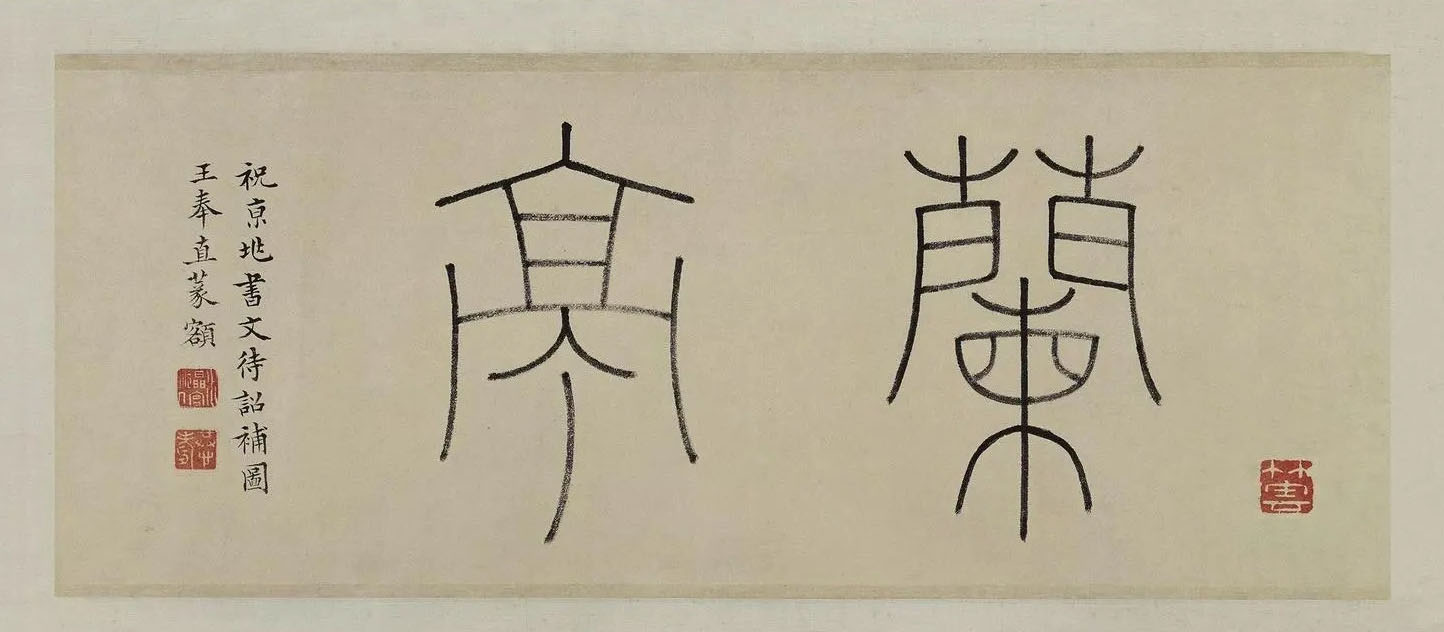
"Lanting Elegant Collection Picture Volume" painted by Ming Wen Zhengming, Qing Dynasty Wang Shu inscribed "Lanting" seal script

Ming Wen Zhengming painted "Lanting Yaji Tujuan" (see the end of the article for the vertical picture)
Wen's drawing is actually a supplementary picture of Zhu Yunming's "Lanting Preface", and there is a postscript in lower script after that, with a lot of emotion: "Zhu Xizhe's book "Lanting Xu" is no less than several copies, and the rest I see is Zhu Xingfu Xiaolian, The collection of Shi Minwang's two literature masters is the best. Now I see this book again, the whole method is "Standing for the Seat Post", and I refer to "Shengjiao Preface" for a little reference. Xizhe did not imitate the ancient posts, but it is vertical and horizontal. , the sage in the real book. I appreciate it after seeing it, and it is a supplementary picture. Occasionally I got Zhao Songxue’s painting scroll, which is exquisite and lovely. Therefore, the use of brushes and colors, one by one, can’t help but follow suit. An Neng Ruxi’s philosophy The book is ingenious and ingenious, and there is no one in the past." In addition, Wang Shu of the Qing Dynasty wrote the word "Lanting" in iron-wire seal at the beginning of the volume, which can be called "Three Bi". The word "Lanting" written by Wang Shu is full of leisure and elegance, and the lower part of the word "Ting" is dealt with, and the arc creates a sense of movement. The inscription has "Zhu Jingzhao's book, the text will be supplemented by the imperial edict, and Wang Fengzhi's seal forehead". Isn't this a kind of "gathering" about the soul that spans time and space?
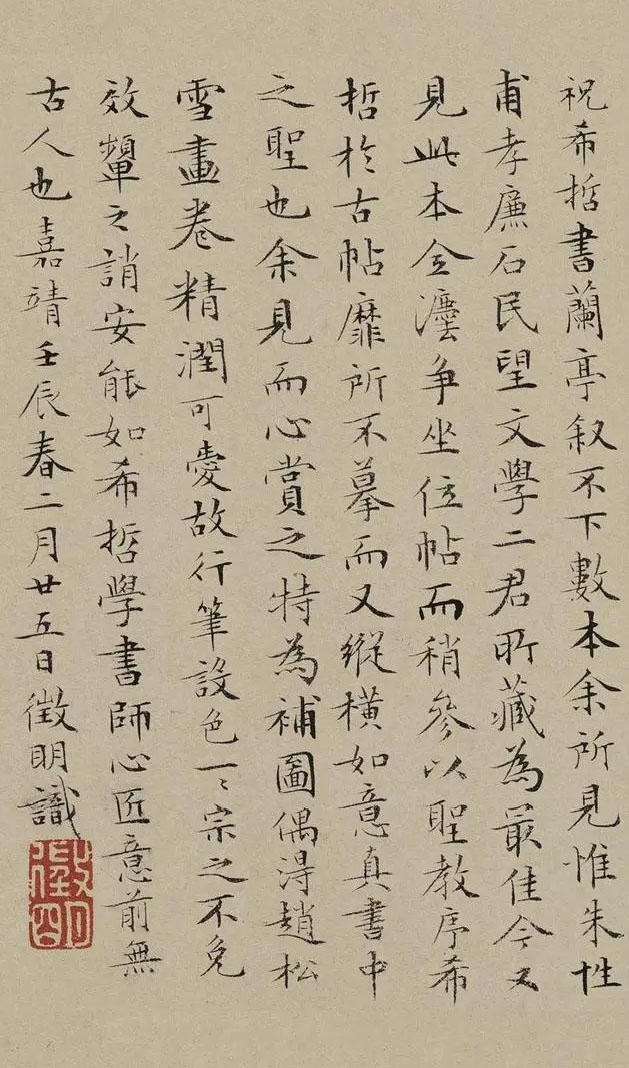
Ming Wen Zhengming's postscript to "Lanting Elegant Collection Picture Volume" Zhu Yunming's book "Lanting Preface"
In the circle of "Wu Men Calligraphy and Painting" at that time, many famous artists favored the painting "Lanting". After the volume of Qiu Ying's "Lanting Xiuqitu", there is Wen Zhengming's "postscript". It is said that it is a postscript, but it is actually very special. Wen Zhengming rewrote the "Lanting Preface" again, maybe he didn't know it was the nth time, so he could recite it backwards. Here is the document of Qiu Hua, and in front of it is the painting of Zhu Shu, which shows Wen Zhengming's diligence and perseverance. After finishing the whole "Lanting Preface ", Wen wrote: "I have seen that there are no less than dozens of "Lanting Ji" written by Mr. Zhao Wenmin, whether large or small, although they are different, the scale and location are not the same. This is the end of the subtlety. I read Qiu Shifu’s "Lanting Picture" once in a while, and once I read it, I lost the standard and changed my face. I am ashamed of Wenmin." It seems that not only Dong Qichang has been competing with Zhao Mengfu all his life, but he seems to be honest. Wen Zhengming also took a deep breath deep in his heart. To put it another way, in their minds, Zhao Mengfu can be an idol, and if they want to surpass their idols, no matter what the result is, they must allow themselves to have enough weight.

"Lanting Pavilion Xiuqitu" painted by Qiu Ying in the Ming Dynasty (see the end of the article for the vertical picture)
Youqiu, who also belongs to the Wu family, painted the "Lanting Xiutu" with elegant and vigorous brushwork, and because of the more textured and dyed, it is quite interesting to Wuzhen in the Yuan Dynasty. First of all, there is the water pavilion, which depicts not Wang Xizhi watching geese at his desk, but four scribes with different dynamics, either unfolding scrolls, watching, leaning on a railing, or talking. Many other scribes who participated in the Gathering had scrolls and books beside them. The addition of these new elements should be related to the customs of the literati in the late Ming Dynasty who were addicted to antiquity and the ethos of collecting famous books and paintings. You Qiu came from a humble background and made a living selling paintings, or he was called Qiu Ying's nephew. In any case, he must have been greatly influenced by Qiu Ying, and had many contacts with brothers Wang Shizhen, Zhang Fengji, and Zhou Tianqiu, who were famous in Suzhou literary circles at that time.
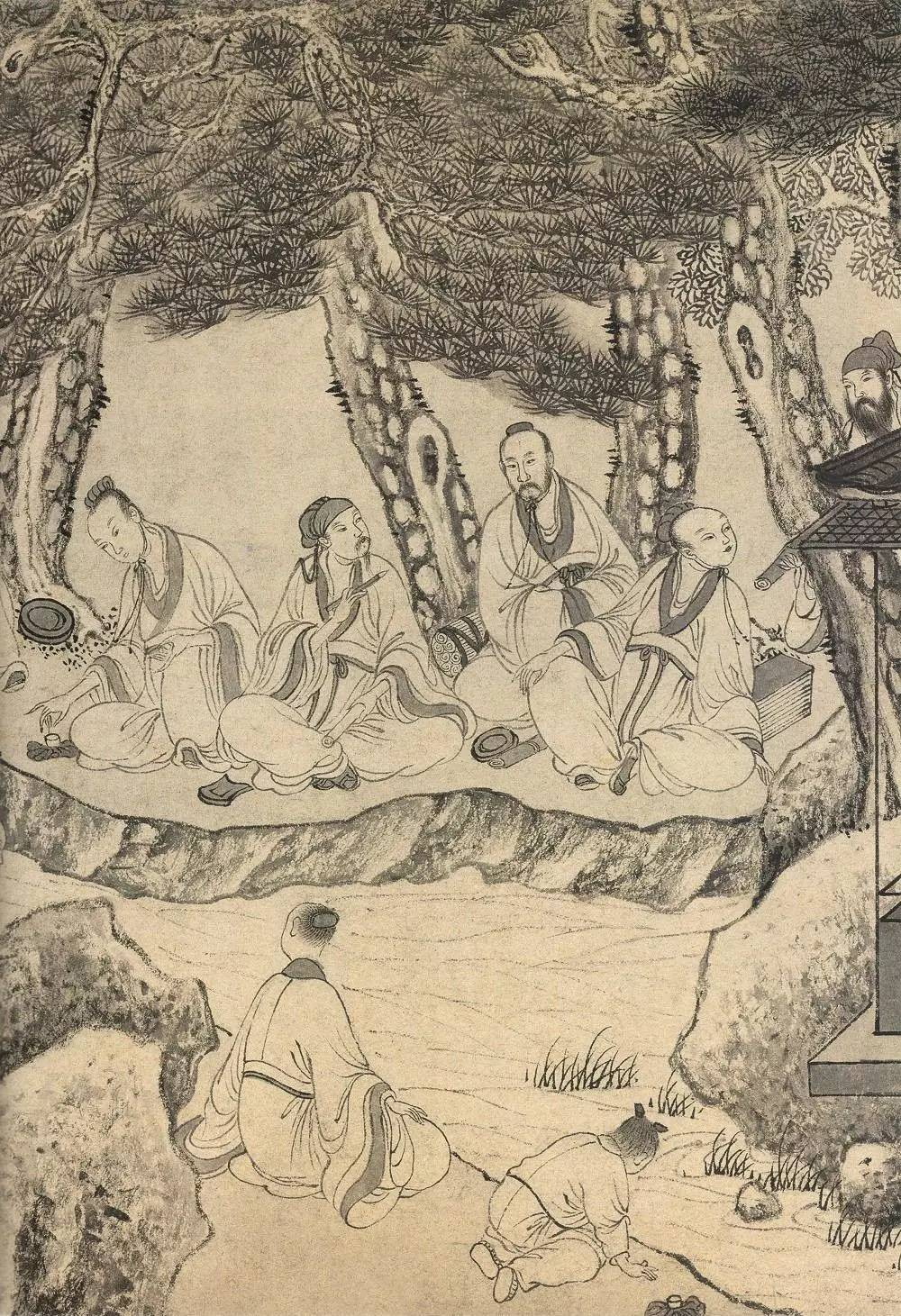
Ming Youqiu's painting "Lanting Pavilion Repair"
There are very few works handed down by Huang Chen, and one of the representative works is "The Picture of Qushui Flowing Cup". With the method of line drawing, the layout of mountains, rocks and forests is interspersed between the characters, which is quite ingenious and full of gentle and refined sentiment of literati. The first section depicts Wang Xizhi watching the geese in the pavilion, two boys standing on the left and right, one boy warming wine behind the screen, followed by forty-one scribes in the Maolin Xiuzhu, sitting on both sides of the curved stream, drinking wine, composing poems, and expressing their feelings . This picture completely reproduces the scene of the Orchid Pavilion repairing the temple and the Qushui flowing cup. It is drawn according to Li Gonglin's picture book, but there are certain changes in the specific drawing methods such as the layout of the scene and the mountains, rocks and trees.
Xu Guangzuo, who was active in the Wanli period of the Ming Dynasty, once wrote "Lanting Picture", and the preface of the book is later. This picture highlights the background of mountains and rivers, showing the elegant things of Lanting repair. Although it has generally inherited the composition method of watching geese in the pavilion and writing poems on the bank since the Song and Yuan Dynasties, judging from the costumes, movements and numbers of the characters in the picture, the painter's performance is more like that of the Ming Dynasty literati imitating Wang Xizhi and other Lanting elegant The situation at the time of the collection, rather than a true reproduction of the original appearance at that time. The scribes and boys are painted on both banks of the stream. The scribes sat in groups. At the foot of the scroll, two scribes came with three boys. There was a pavilion beside the stream. A table was set in the middle of the pavilion. on the side. The postures of the characters are different, some are watching famous paintings, some are washing their feet in the water, some are topless and undressed, some are dancing, and some are meditating, or talking, or observing, or waving. The painting even intentionally shows a pair of scribes drinking a cup of wine, sitting on the floor, holding each other's cups to each other's lips impressively. People turn a blind eye to them and are not surprised when they see them. Although these behaviors also appear in Li Gonglin's picture, generally speaking, the behavior shown in this picture is more unrestrained and exaggerated, which shows the unrestrained habits of literati in the late Ming Dynasty. The clothes of a few characters are painted pink to form a special effect.
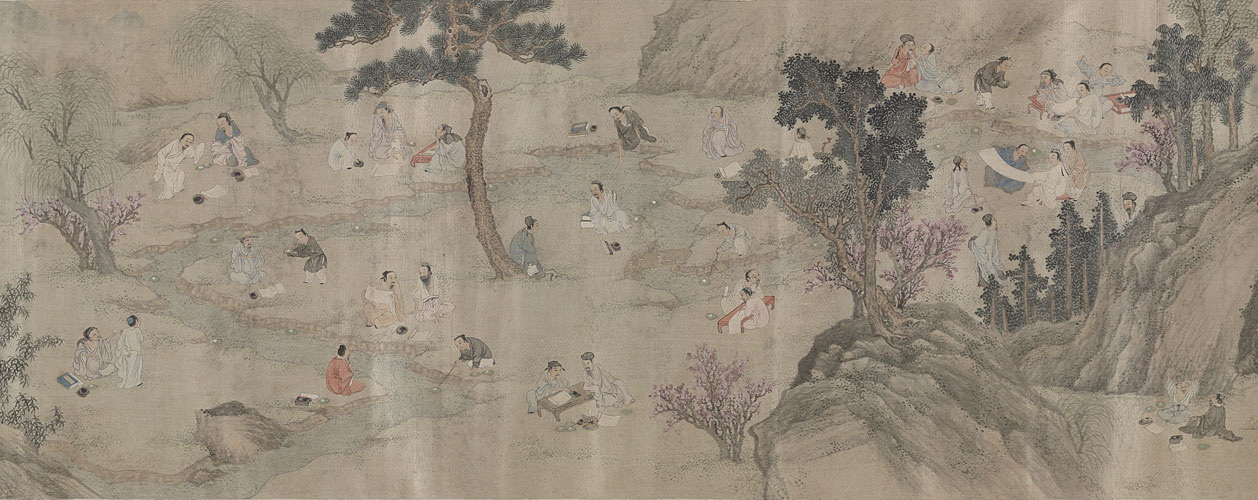
Ming Xu Guangzuo painted "Lanting Picture" volume
The painters Lu Xue and Zhao Mengfu in the early Qing Dynasty were from the same hometown, and they were named Haiyue, and they also had a "destiny" with Mi Fu. "Orchid Pavilion Repairing Gods" not only has luxuriant forests and bamboos, and flowing water, it is not only a masterpiece of green landscape painting, but also a masterpiece of figure painting. The brush is neat and elegant, and its shape and brushwork are very close to the style of Qiu Ying's "Taoyuan Wonderland Picture". In terms of the use of color, lapis lazuli, azurite, and anthracite are used for dyeing. The "white" of the characters' clothing and the "green" of the rocks form a sharp visual contrast, which is the inheritance and development of Qiu Ying's style along the way. The green and heavy colors can not only render the brilliant and gorgeous beauty, but also create a sparse and beautiful environment, and can even refine the elegant and fresh character. Yun Nantian said: "The heavy color of green and green is easy to be thick, but difficult to be light, and it is difficult to be light, and the thicker it is, the more difficult it is." You must know that in Chinese landscape painting, there is coloring first, and then ink and wash. In color-setting paintings, there are heavy colors first, and then light colors. Zhang Geng in the Qing Dynasty said: "Painting, painting is also a thing, and it has always been colored in ancient times, and it is mostly green."

Qing Dynasty Lu Xue painted "Orchid Pavilion Restoration Picture"
If we say that the "Lanting" and the series of "Lanting Picture" scrolls are the "Lanting Complex" on the bright side, and the creation of calligraphy, painting and seals related to the Shangsi Festival is the invisible "Lanting Complex".
Ni Zan is good at painting landscapes in ink and wash, and "Empty Forest After the Rain" is one of his rare works in color. In most of Ni Zan's works, the scenery is extremely simple. This work depicts tall mountains and rivers. Most of the mountain stones in Zhongshan paintings are covered with hemp, folded with chapped, dry brush and light ink, thick ink with moss, and the color is light and gentle. The tall mountains are painted, and the small waterfalls flow down through the rocks from the mountain streams and merge into a water area at the foot of the mountains. In front of the mountain, there is a small river that winds and flows slowly, with stone bridges across it, and the water waves are calm. The terrain on both sides of the strait is low and flat, the sparse forest is empty, and there is a house under the forest, and the scene of people going to the house is empty. After the rain in the mountains and forests in the south of the Yangtze River, everything looks dense and empty, presenting the scene of the forest and the sky after the rain, and a light and desolate environment. The inscription reads: "After the rain, there is white smoke in the empty forest, and there are flowing springs everywhere in the mountains. I was looking for Lu Yu to live in a secluded place, and I just listened to the bell and thought nothing." With the help of this poem, you can fully understand Ni Zan's state of mind when painting and feelings. The quaint and elegant style of lower case script is integrated with the picture.

Yuan, painted by Ni Zan, "Empty Forest After the Rain", Wushen Shangsi
The formation of Ni Zan's calligraphy and painting style is largely shaped by his personal temperament and mentality of the adherents. Bada Shanren, survivors belonging to different eras, came to "Lanting" happily all their lives. At present, there are nearly 20 "Lanting Prefaces" that have been handed down. To be precise, some of them are called "Linhe Xu". Using "Preface to Linhe" instead of "Preface to Lanting", I like the old and dislike the new. What is reflected between the lines is the unique spirit and the unforgettable resentment of the motherland. The calligraphy styles of the eight mature periods are mainly written in regular script and cursive in regular script. They have strong and aggressive personalities, strange styles, and unusual styles, which are the reflection of personal mentality. In his early years, Dong Qichang, the patriarchal style of calligraphy, was still based on calligraphy, one is the truth, and the other is the disguise. The eight major works seem to have no direct relationship with "Lanting Preface" itself, but it cannot be said that there is no relationship at all. As mentioned earlier, studying "Lanting Preface" is not only about techniques, but also about spiritual factors. If you can't understand Wang Xizhi's inner world, your skills will only be superficial. This is why learning Wang characters becomes popular.
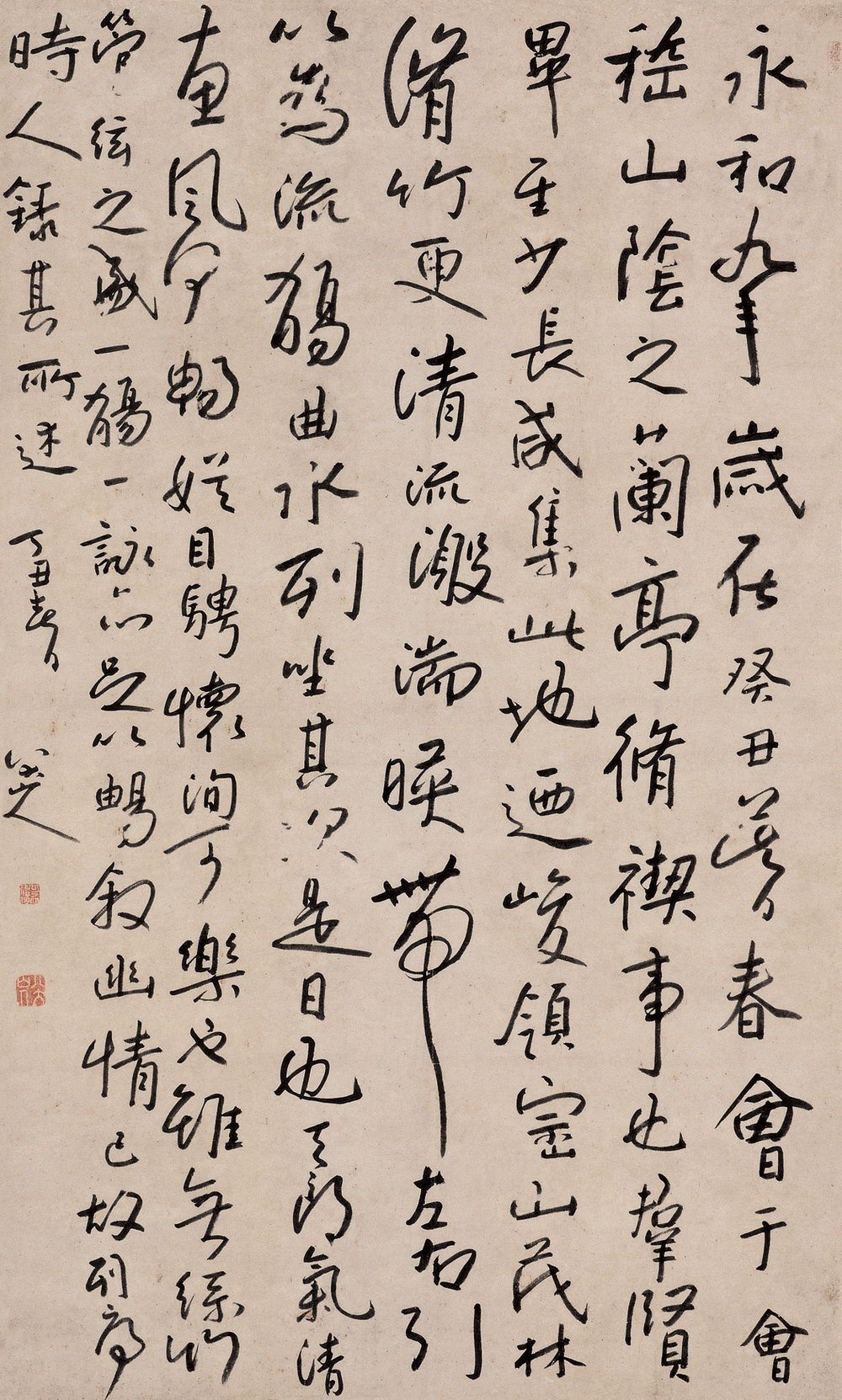
Bada Shanren of the Qing Dynasty presents "Orchid Pavilion Preface"
In Yuan Dynasty calligraphy circles, Zhao Mengfu belonged to the figure who covered the sky with one hand. With the continuous excavation of various materials, other calligraphers in the Yuan Dynasty continued to re-excavate and became more abundant. Among them, Yang Tieya and Kang Lizishan had to write chapters, Xian Yushu and Zhang Yuchu learned from Zhao Mengfu, and later opened up their distance. Zhang Yu has more of a wild and strange look, which is rare in the works created by Shuda. It does not break away from Zhao's stereotypes, while the inscriptions and letters have a refined or intense style, showing a personal appearance. Xian Yushu's postscript has the ancient rhyme, the pen of "Shengjiao Preface", and the style of old rice, which is smart and natural, and has a new look.
Wang Duo has the highest voice in the entire Wang Xizhi calligraphy system. He has the pride of "my family Xixian", but also the pain and heaviness of being a "second minister", and urgently needs to prove that he belongs to the capital of Zhengmai. Wang Duo had repeatedly copied "Orchid Pavilion Preface" and "Shengjiao Preface", and wrote "Lanting Pavilion" in the style of "Shengjiao". Wang Duo's life is countless, and there are more than 300 pieces handed down to the world. He will study repeatedly for the most favored calligraphers. Among them, except for the two kings, most of them are Chu Suiliang and Mi Fu. Wang Duolin's "Lanting Preface" favors the copy of Chu Suiliang, which can be said to kill three birds with one stone: learn from the two kings, learn from Chu, and also learn from Lao Mi. Chu Suiliang is a rare calligrapher who has not seen any negative words in Mi Fu's life. From being charming, but not having a delicate look", it can be seen that Chu Suiliang is Mi Fu's idol, and Mi Fu is Wang Duo's idol. It is self-evident that such a relationship can be close layer by layer.

Qing Wang Duolin and Chu copied the "Orchid Pavilion Preface"
Wang Duo was in "Gengyin Shangsi" when he came to Ouyang Xun's "Beriberi Tie", and he was nearly sixty years old. This is Wang Duo's attempt to "expand and make it bigger" in his later years. Several characters or even tens of characters are formed in one stroke. . Through the internal space of the glyphs, it affects the overall density contrast change, the ink color changes naturally, and the contrast between virtual and real is strong.

Qing Dynasty Wang Duolin's "Ouyang Xun's Beriberi Tie" silk version, Geng Yin Shangsi
Interestingly, Wang Duo would sometimes choose some "unpopular" calligraphers, especially in his later years, find out "Chunhua Ge Tie" and "copy" them one by one. Auxiliary" thinking. The inscriptions are: "Dinghai March Shangsi day, I even imitated Taizong's book, at the age of fifty or six, in Yanjing." The word "imitation" is used, not imitation, nor imitation. nuance. The word "Yanjing" is full of bitterness. When Wang Duo descended to the Qing Dynasty, he was depressed, so he could only use calligraphy to relieve him. The strokes are aggressive, the characters are flying, the thickness of the strokes is ups and downs, and there are occasional continuous strokes, intentional or inadvertent, where you can often see where the meaning is. The most interesting thing is that it is added at the end - "'Shang□' is mistaken for 'Shangsi', distinguish it". It is not on "Shangsi Day", but subconsciously written as "Shangsi Day", which shows Wang Duo's inner obsession with Wang Xizhi.
Occasionally, Wang Duo's long poem "Tianjin Guanhaikou" is written and signed "Dinghai Shangsi". That is to say, even if the two works are not on the same day, the writing time is very similar, but the brushwork is very different. This long scroll method is actually derived from the book "Liangjian Wendi Xie Chilai Fang Zhujian and Other Enlightenments" written by Wang Duo at the age of 55. Many fonts are almost copied here. For Wang Duo, who is very creative, it must be impossible. , so it is undoubtedly a fake.
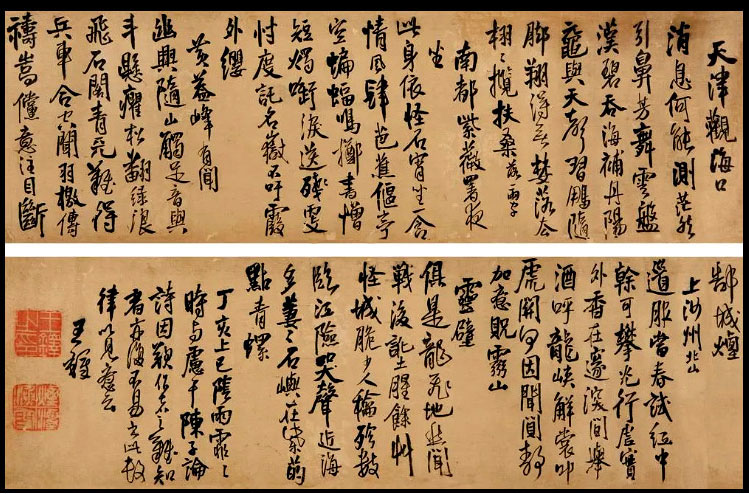
Wang Duo's "Tianjin Guanhaikou" Poem Scroll
The same is Xue Wang, Xue Yan, Xue Mi, Dong Qichang's calligraphy can be described as beautiful and delicious, vaguely revealing the charm of Wang Yanmi, seemingly but not similar, bringing the characteristics of elegance and elegance to the extreme. Regardless of any calligrapher, there is something remarkable in bringing a certain style to the extreme. Among them is Tang Lulun's poem: "Zhaoyang's companion is the smartest, and he grows up in the world. Knowing that the forbidden song is difficult to translate, it is still the king's nickname." Finally wrote Tang Wangwei's poem: "Cuju has repeatedly surpassed birds . On, the swing races out of the Chuiyangli. The young people travel in different days, and they don’t need to go to the Qingming Festival.” Putting this poem at the end has a special meaning and becomes the “node” of writing time. From this, I can’t help but think of Song Huangsheng’s "Congratulations The sentence in "The Bridegroom": "Charming face, try to stand still, sit on the romantic seat and talk about the dust. More affection, talent and tune, slow song golden thread".
According to the actual calligraphy level of Qianlong, it was purely "soy sauce", but he had a special hobby for "two kings", which came from the heart and expressed in words. With the power of the emperor, he forcibly created a "three Xitang ". On the Shangsi day when Qianlong was 48 years old, he specially presented "Orchid Pavilion Preface" in Sanxi Hall, which shows that he has a close heart. Although the strokes of Qianlong's common works are bloated, soft and stagnant, and it is hard to hide the vulgarity, the "Orchid Pavilion Preface" performed very well. The other side of Qianlong's calligraphy.
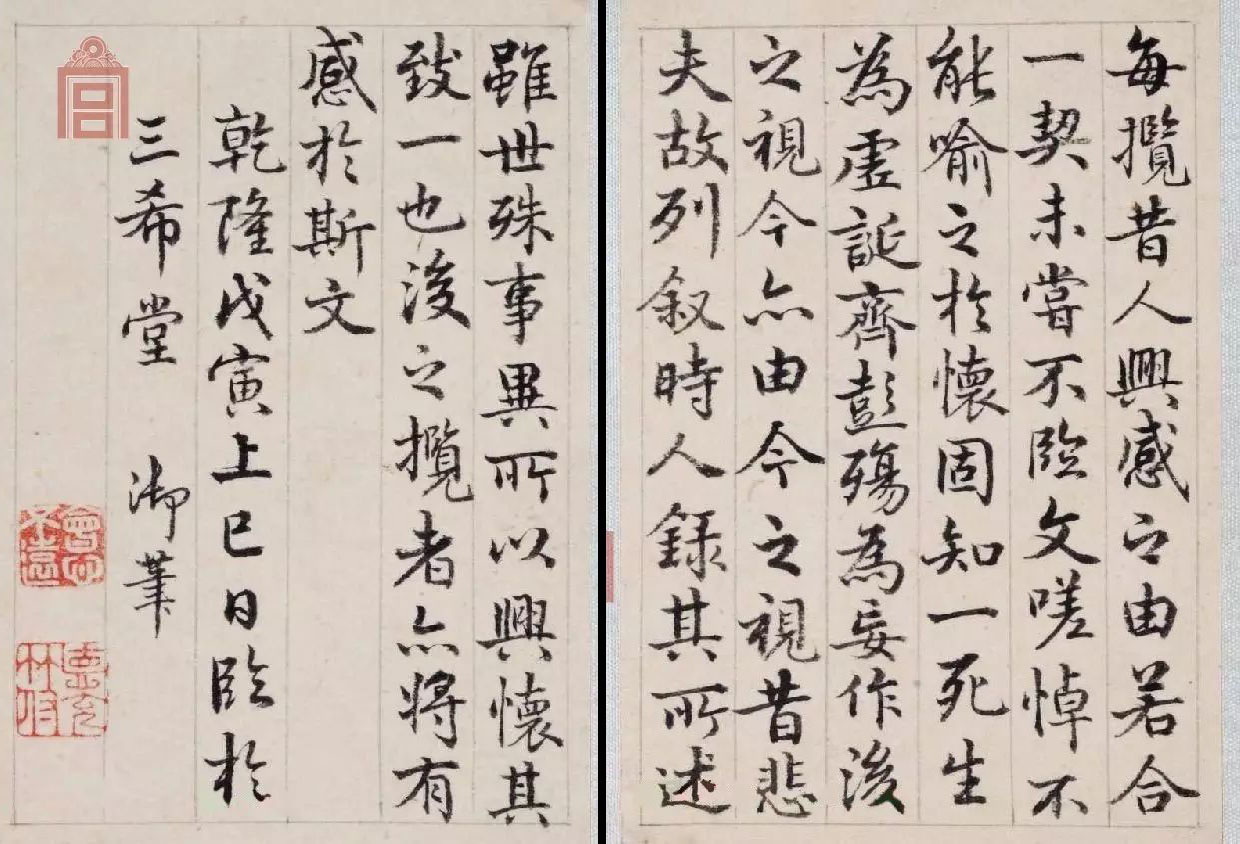
Preface to the Lanting Pavilion by Emperor Qianlong of the Qing Dynasty, Wuyin Shangsi
The couplet of "Flowers and Birds Singing, Beautiful Sun and Wind, Spring and Su" further witnessed Qianlong's enthusiasm for Wang Xizhi and even calligraphy. Qianlong's calligraphy started from learning Zhao Mengfu, and he admired and pursued it with his hands, and practiced it personally. The stippling is round and even, the structure is gentle and smooth, and it is mostly vertical and long. The regular script contains the brushwork of running script, and the running script is often mixed with the charm of cursive script. Although there is an image of peace, there will be no heroic style in the end." It can be said to be in the middle of the phrase. From the perspective of the combination of temporary creation, the relationship between each other is subtle. The temporary work has something to rely on, and the difficulty is lowered. The creation is "out of thin air", and the difficulty is higher. In fact, both are equally difficult to come up with new ideas. There are ancient and I have difficulties, and the former is difficult. Unintentional, you have to be intentional from time to time, the latter is difficult because you need to be unintentional, sometimes you need to be unintentional, and unintentional is good.

Qianlong "Flowers and Birds Singing and Stories Are Bright, Beautiful Sun and Breeze Spring and Green Su" couplet
In Shangsi, the 17th year of Jiaqing, 59-year-old Yi Bingshou left a manuscript of poems, which has no obvious traces of alteration, and it is speculated that it should be copied into a manuscript. "Limo Shen misunderstood many people, and the doctor's name is Gao Guying'e. He said that he was a calligrapher who passed down the Jin Dynasty, so how did he defect to Dongpo at the end of the festival?" Yi Bingshou admired Su Dongpo very much throughout his life. The two had a certain kind of tacit understanding and fate. They are well-educated and talented scholars, proficient in poetry, calligraphy and painting. They are all feudal officials with good political reputation; The places where Yi Bingshou spent the longest time as an official in his life were Huizhou and Yangzhou, and Su Shi also stayed in both. Yi Bingshou served as the magistrate of Huizhou for four years. Like Su Shi, he "asked the people's sufferings, eliminated bad rules, and practiced the law without avoiding arrogance." "Xin Liu " writes a poem about the scenery: "The tailor leaned on the Zhulan and doubted the evening smoke, so he climbed the corner of the building to reach the sky. When I am old, I feel Heng Sima the most. I used to comfort my waist before eating cold food." Su Shi is mentioned here again, although he did not directly name him. However, Su Zi's "Cold Food Post" is famous all over the world. Yi Bingshou's official script with a strong personal face dominated the calligraphy world of the Qing Dynasty. It is heavy, large, clumsy, and thick. It is in sharp contrast with official script. Yi Bingshou is undoubtedly the most "modern consciousness" calligrapher.
Yi Lixun is the great-great-great-grandson of Yi Bingshou, who can pass on the family law, has skill but little taste, which fulfills the saying that "the most important thing to learn is the law, but the magic lies in the person". Yi Lixun has always liked to collect "Yishan Monument", especially many of which have been handed down from generation to generation. "Deyi Weiming has both functions, and the brokerage is good and profitable." The title of the above paragraph is "Abiding by the ancient law, which is different from the inscription on the Han stele", which is worth pondering. "Abiding by the ancient law" is true , abide by the center, pursue a quiet and solemn attitude, and have an ancient style, but the pen is out of Han Zhuan, especially the characters are mostly square or close to square, not dense at the top and sparse at the bottom, so it feels plain. Yi Lixun was able to not blindly follow the "family law" and insist on innovation, but it is a pity that he failed to go further and showed a cautious attitude.
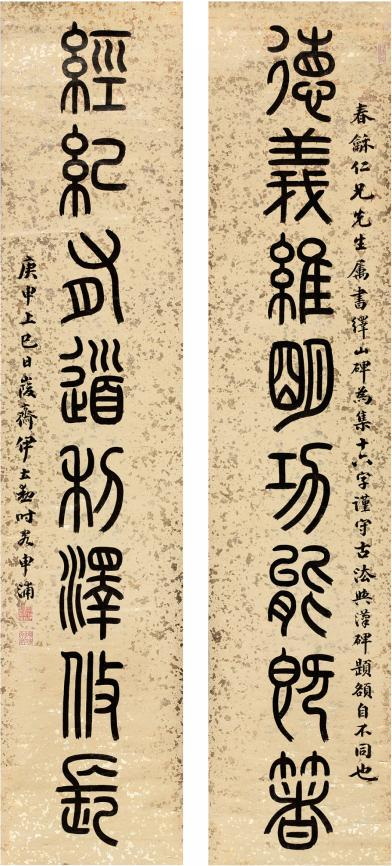
Qing Dynasty Yi Lixun "Deyi Brokerage" seal script couplet, Gengshen Shangsi
Yuan Mei was a great talent and celebrity in the Qianlong era. The "Yu Village" on the rise is Xu Xuan, the son of Yuan Mei's old friend and famous doctor Xu Lingtai. This identity can correspond to the illness mentioned in the letter. "Two days after Huachao Festival" received the letter, and the date of reply was "one day before Shangsi". At the beginning of the narration, I talked about my illness, and the key point is the words "the vitality of the eighty-year-old man is seriously injured", which shows that this letter was written by Yuan Mei when he was an octogenarian. Yuan Mei called himself "Old Man Suiyuan", so he was modestly called "Old Man Huai". Because he was the only boy in the family, he was cared for since he was a child. He once laughed at himself in "Miscellaneous Poems of Autumn Nights": , Grandmother loves Jiazhen. In the arms of the elderly, a weak crown is like a concubine." Yuan Mei worked extremely hard all his life, and the older he got, the more he did so, which eventually helped him delay aging and became an evergreen tree in the literary world. In 1797, Yuan Mei once wrote a poem "Consciously Declined After Illness, and I am Not Old in Pen and Ink": "Once you get sick, you will know you are old, and your face will be as thin as a crane. The waistline will be reduced by three inches, and the clothes will be loose all over the body. Seek out customers first." If you look at the flowers, you will be shy of the wind. You only carry a double-barreled pen, not like an eighty-year-old." The words in the poem and the letter can be matched, so that the writing time can be calculated. The whole book is exquisite and meticulous, with occasional ties and hints, imitating Zhao Mengfu and Wen Zhengming, and full of literary spirit, which is memorable, without any signs of aging.

Qing Dynasty Yi Bingshou "Ren Shen Chucao" 24 pages (choose two), Renshen Shangsi
Sun Xingyan was a famous seal script master and a great collector of books in the Qing Dynasty. Running script is rare, and the title "Hu Luojun's Small Hidden Picture Around the Mountain" is a personal masterpiece. "The family of Confucian classics has been stable since then, and Tiger Bi took the seat to Lantai. Pu Lun will never fail to seek talents, and Xiao Yin will also recruit Da Yin." Between the lines, the style is full of style, and it is based on Dong Qichang and Wang Wenzhi, but slightly changed its method, taking Li Beihai is drawn to the general idea, and it has both law and meaning. On the occasion of "the fifth year of Jiaqing", Sun Xingyan was 48 years old. The key is that the last four characters "written in Shanyin" are exactly the place of Lanting in Shaoxing, which may be a convenience for "pilgrimage". Writing with feelings added a good story.
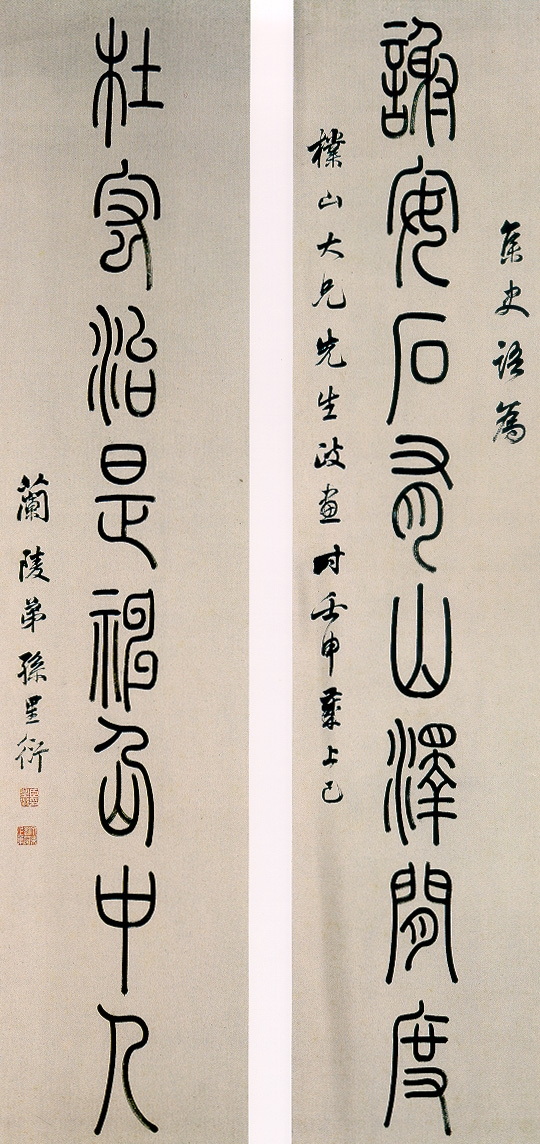
Qing Dynasty Sun Xingyan "Xie An Du Hong" seal script couplet, Renshen Shangsi
The eight words of Sun's seal script "Xie Anshi has mountains and rivers to spend leisurely, Du Hongzhi is a man of gods" is a collection of historical words, elegant and quiet, although it is similar to Wu Rangzhi but different, it is mainly round, but different from Mo Youzhi. In the Qing Dynasty, seal script writers emerged in large numbers, and it was not easy to have a place in the high-density form. The content of this couplet has the meaning of Linquan, which matches with personal aspirations. The two works were created 12 years apart, but the breath, style and even the general interest are consistent.
He Shaoji's "March 3rd Hualin Garden Horse Shooting Fu" has four screens in seal script, and the content is exactly a poem written by Yu Xin for the Shangsi Festival. When is it nearly ancient. Eye disease in the old age, writing books is based on intention, the pen is light and dry, not as calm and handsome as middle-aged, but every time there is a wonderful feeling of meaning before the pen arrives. The beauty and kung fu of its seal script are all in the use of pens, which are jerky and old-fashioned, full of spirit of gold and stone scrolls, and have their own style. Writing Xiaozhuan with the brush of bronze inscriptions, and seeing the cursive brushwork, the changes are vivid and unpredictable. The beauty is that a clumsy word can also have an interesting word!

Qing Dynasty He Shaoji Shu Yu Xin "March 3 Hualin Garden Horse Shooting Fu", Ding Maoshangsi
Reading Huang Shiling's inscription "At the beginning of my life, I was in Bingchen, but when I was Shangsi" , I can't help but think of "Wei Geng and Yinwu have come down" in "Li Sao Jing". This seal uses a single knife, which is vertically and horizontally folded, which is full of interest and interest. The seal character is transformed by the official method, and the shape of the characters is flat and square. Several slanted pens are boldly used in the printed surface, such as the four characters "I, Chu, Sui, Wei", which makes the printed surface dynamic and breaks the order. The retraction of the strokes creates an inadvertent redness, which makes the breath ethereal. Because the strokes are thin, the contrast between vermilion and white has no charm. Side inscription: ""Zhu Bo Remnant Stone" was unearthed far away, and I went to the capital to see it first. I spent a long time playing with the case, and I was so excited that I copied this seal for Yunzhen. When Yunzhen saw it, I should know the depth of Yu's intentions." These words have witnessed the development and changes of Huang Shiling's development and changes in the three years before and after his arrival in Beijing, where he extensively dabbled in Zhou, Jin and Han stones, transferred to many masters, and finally became self-cultivated in ancient times.
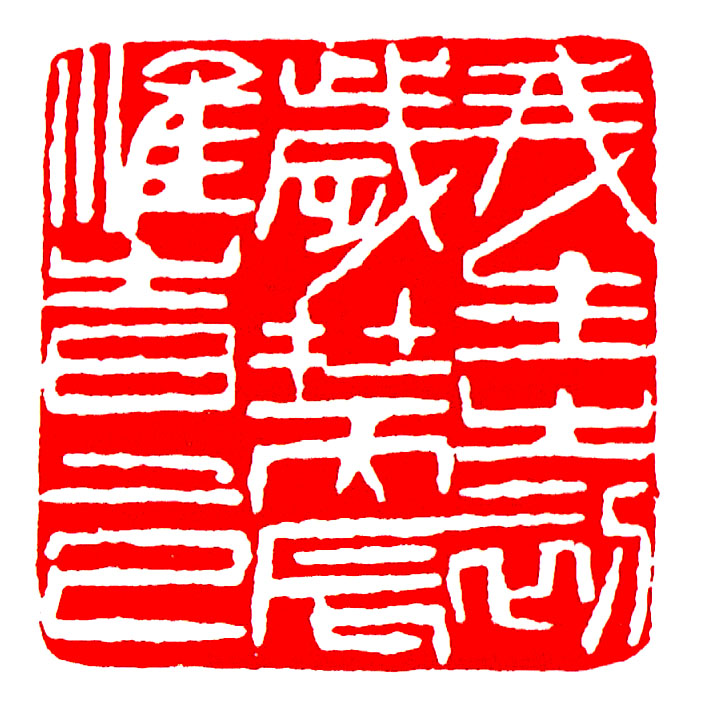
Qing Huang Shiling Carved
"Wopantuo" was engraved by Shi Huan in the Qing Dynasty, with the character Zhongchen, born in the capital, and native of Wujiang. He was friendly with Hu Yizan, but died at the age of thirty. The inscription is "Yihai Shangsi, engraved by Mr. Liansheng" , and it is marked with "Tongke Jingshi"-equivalent to today's "Beipiao", which shows the deep nostalgia for the hometown in the heart. This seal has Wu Rangzhi's demeanor, the fusion of square and circle is just right. The sidebar is broken, especially the ingenuity. Whether it is unintentional or intentional, it is just right. The seal method is natural, the density is appropriate, and the brushwork and knife meaning are presented together, which can be regarded as a proud work in his life.
The content of Zeng Xi's work is to comment on Qian Feng's running script, "Nanyuan was able to benefit from Henan's "Fu on Dead Trees", and later entered it with the rice method, so it is unique." "Jisi" was in 1929, the year before his death. Qian Feng's regular script came out of Lu Gong, which further strengthened the characteristics of Yan. His running script is more similar to Yan and rice. Yan Congchu's origin is true, it can be said to be right in one sentence, directly exploring the source. Zeng Xi's work is due to the "Yu He Ming", "Huang Ting Jing", "Shi Men Ming", "Zhang Hei Nu" and other schools. It is dedicated to smelting into one furnace, purely with round brushes, elegant and elegant.
"Renhe Gao Yongzhang" is Wu Changshuo's masterpiece imitating the general seal of Han Dynasty. From the perspective of the entire seal surface, there are three irregular red bands on the top, the middle horizontal band and the bottom, which make the seal breathless. A large piece of red is left at the word "Ren", echoing the red at the bottom of the word "Zhang", and the red at the bottom left of the word "He" is the finishing touch. If this place is filled, the seal will be greatly inferior. The inscription was "Heavy Rain on Shangsi Day, Bingchen, Guangxu". Wu Foulu was 32 years old.
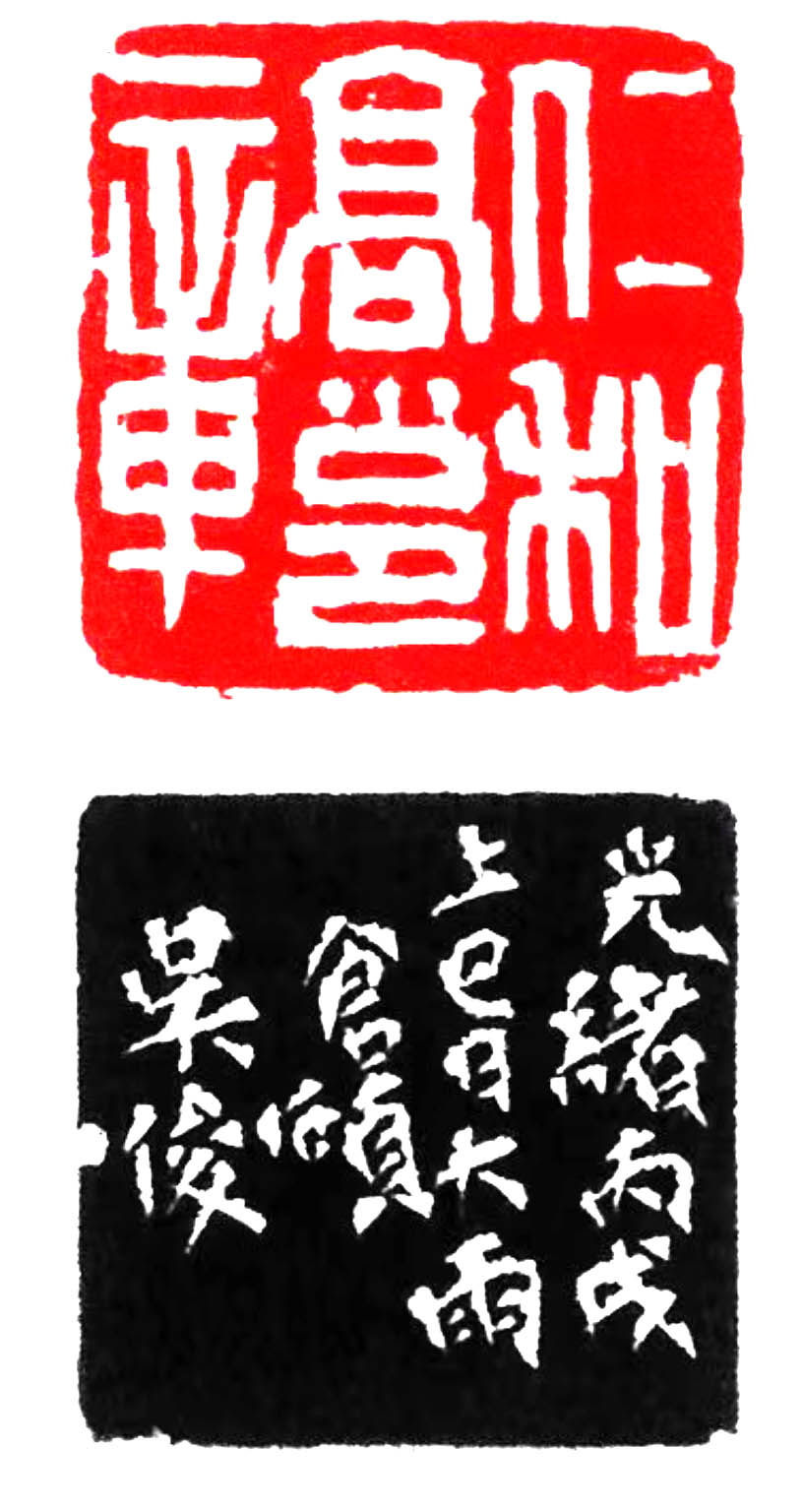
Modern times Carved by Wu Changshuo, Renhe Gao Yongzhang, Bingxu Shangsi
Wu Changshuo's engraving of "Deaf to Officials" is an organic combination of single and double swords. Those with thin strokes are chiseled with one knife, while those with thick strokes must be made with double knife, double knife and supplementary knife. All the outlines of the characters are thinner, thus showing a sense of hierarchy, with the right side left and the left full, slightly In contrast, the curved pen of the character "Yu" echoes the curved pen of the character "Deaf". There are three red places on the printed surface, mainly at the lower right of the word "魔", and under the characters "Yu" and "Official", forming a "triple-footed trend", and the red between the characters "Yu and Deaf" adds to the ethereal atmosphere. . "Today the emperor judges by the voice, and the ministers fear that the emperor will be deaf to the official ears" comes from "Warring States Policy · Wei Ce", Wu Changshuo used the meaning of "deaf to the official" to show that he is not in the officialdom. The time was "Jihai March 3rd", Wu Changshuo was 56 years old, and Yinfeng was already precocious, and at this time, he was even more handy.
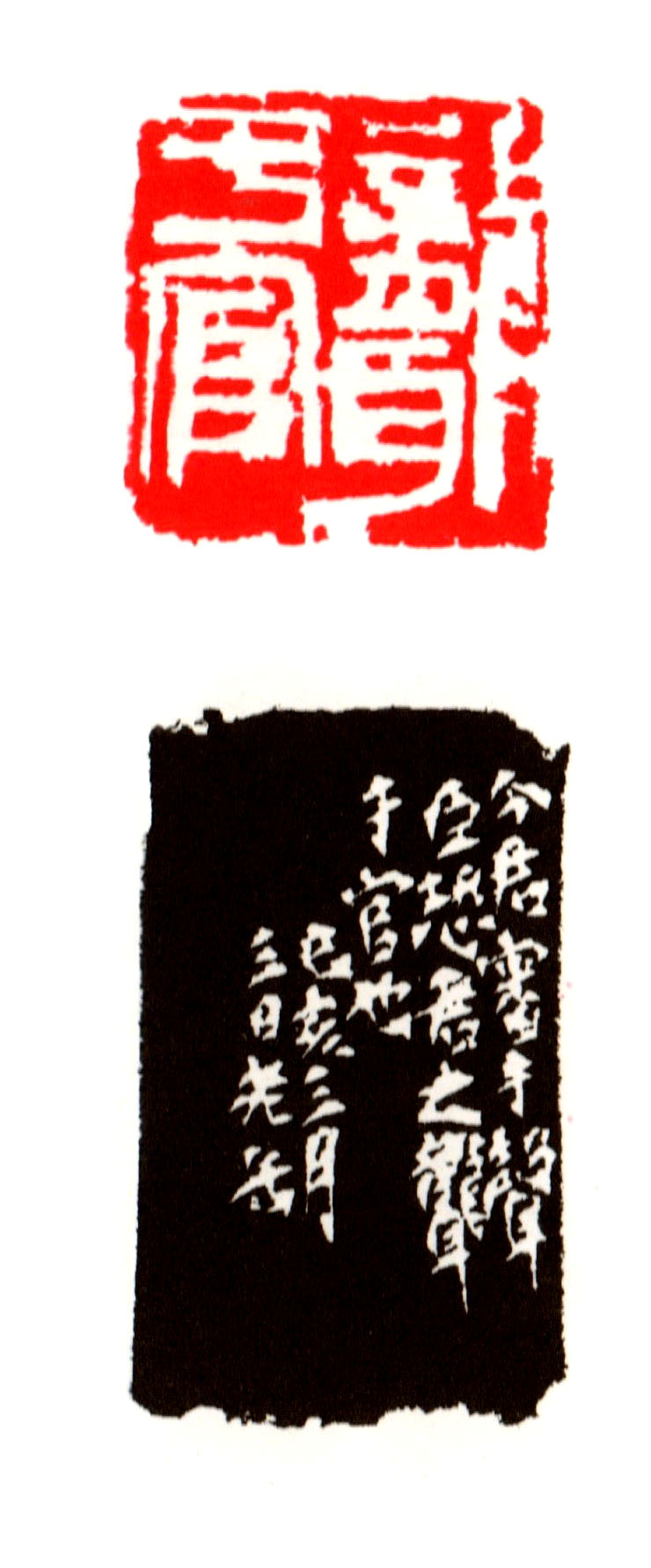
In modern times, Wu Changshuo was deaf to officials, and Jihai Shangsi
Wu Changshuo has another poem "Renzi Shangsi Tour Liusan Garden", which reads: "The fun is more interesting than the mountains, and people don't donate much. The Buddha's clothes welcome the sea, and the pine air falls. The stone path is cloudy and green, and the cherry blossoms are beautiful. The powder stains are fresh. The majestic sound of nature is in the air, and the poem is so good." Wu Changshuo's running script combines the essence of the brushwork in seal script, official script, regular script, and cursive script. From the point of view of style and technique, it is mainly influenced by the Huangshan Valley, the structure is tightened in the middle palace, and the stippling is stretched. At the same time, it is also influenced by the cursive script of Huai Su and Wang Duo, forming a style of mixed lines and grass, which is flexible and changeable , Qiurun steep and dangerous.

Wu Changshuo's poem "Renzi Shangsi Visits Liusan Garden"
Tai Jingnong Lishu couplet is quite meaningful. The content comes from "Tongren Shuhuai": "Heroes are suspicious of rogues, and they are full of spirit when they sing in wind and rain." Mainly take "Ode to the Stone Gate" and "Heng Fang Bei", the pen trembles, bends like iron, and adds the Wei Bei brushwork. The font is square and square. The master, dignified and elegant at the same time, increases the simplicity of the atmosphere, the edge is powerful, and the strangeness and righteousness coexist. The last paragraph has the words "Bingchen Shangsi, Xingzhi Oushu". "Bingchen" was in 1976, and Tai Jingnong was 74 years old. "Xing Zhi Ou Shu" shows that when many calligraphers arrive at "Shangsi", more or less unconsciously, they will think of Wang Xizhi, and when they are full of enthusiasm, they will splash ink and leave excellent works.

Contemporary Tai Jingnong "Heroes and Storms" couplet, Bingchen Shangsi
Chen Shi once engraved the "Chen Yu" seal, showing the beauty of separation and reunion of the branch, with the charm of ancient seals and Qin seals, dyed in the blue but not limited to the blue. The lower right of the character "Chen" is left red, and the middle part of the character "Chen" is left red, which makes the printed surface ethereal and vivid. The engraving of the inscription reads: "I did not go to the temple, but my master played the knife. It was in the sound of Liushui, and dozens of people repaired the collection." It seems that Chen Shizeng is also full of admiration for Wang Xizhi from the bottom of his heart.

Modern times Chen Shizeng carved
Tong Danian, who has a plain and simple seal style, learned from Chinese seals and can change, strengthen the sharpness of square folds, and present his personal appearance. However, the strokes are sometimes too blunt, causing the glyphs to not blend with each other. According to the meaning of "the wine in the bottle is not empty", it should be more frank. It can be seen that although India is a small road, it must be operated on the basis of a large road in order to be handy. Shitong is 48 years old, and he has already gained a foothold in the sea of masters.
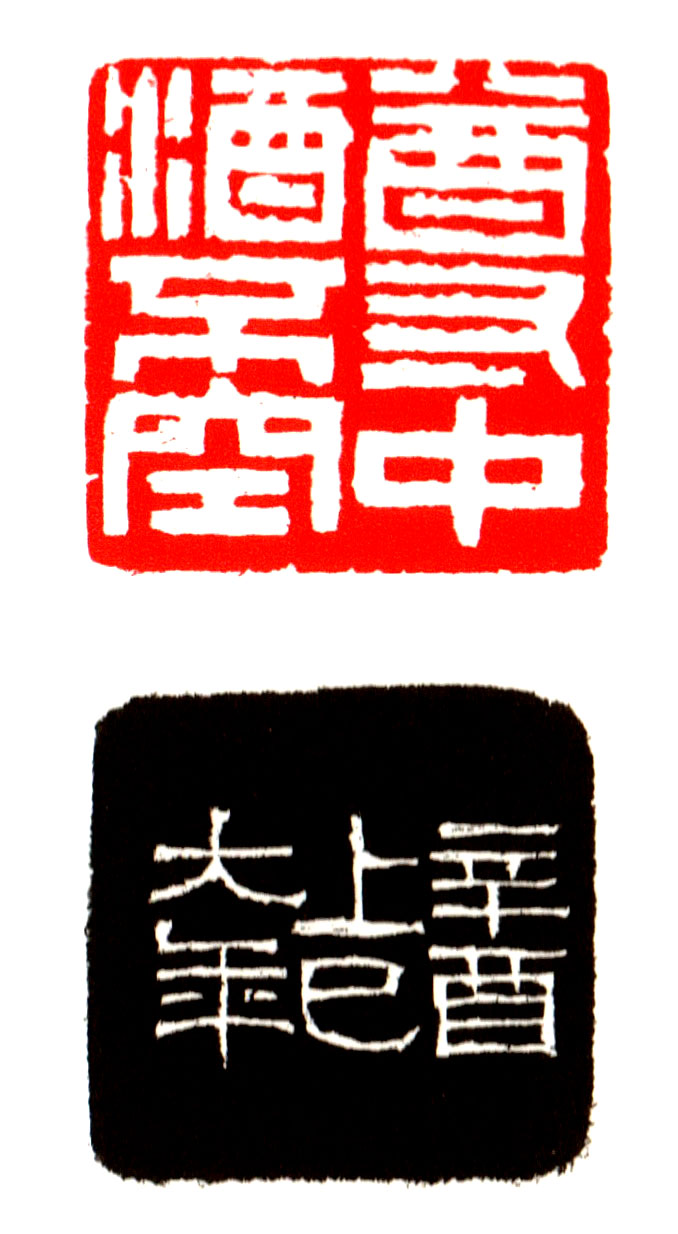
Modern Tong Danian engraved The wine in the bottle is not empty, Xinyou Shangsi
Han Deng'an's seal cutting is also good at plainness and simplicity, and does not rely on exaggeration and deformation. Because of the foundation of Han seal, it has a strong atmosphere, gentle and dignified, but it is a pity that he cares too much about both square and round, which eventually leads to a little lack of personality. The note on the side note: "President Yin Mo teaches Zheng. Jiachen Shangsi Day", choosing a date is not as good as hitting the sun, which is full of commemorative and symbolic significance.
"Sha Wenruo sampan" inscription: "Jichou was engraved on Xiaoshani Street and lived in Xiaoshani Street. Meng Gongji." "Jichou" means 1949. Sha Shi was 50 years old. He was middle-aged and had the title of "Meng Gong". say. This seal is divided by the outer side column and the vertical inner column. The seal method is taken from the big seal, which has the meaning of boundlessness, which can be said to be the Samadhi of the ancient seal. Choosing a date to engrave seems to be a deliberate work.
When it comes to "Lanting Preface", there is one person that cannot but be mentioned, and that is Su Shi. Although Su Shi did not appear in the "Lanting Preface" works handed down, but Su Shi and "Lanting Preface" have an indissoluble bond. Among the masterpieces of Su Shi’s life, if a famous article similar to "Preface to Lanting" is selected, it should be "Red Cliff Fu". In terms of style, it can be understood that Dong Qichang appreciated "Red Cliff Fu". The change of Fu Chusao is also the change of this book "Lanting". Song people's writing is based on this." But in terms of feelings, it should be "Cold Food Post". In Su Shi's life, there were many poems and other words about "Lanting", such as "Sun Shen Laoqiu Mo Miaoting Poem": "The cocoon paper of Lanting enters Zhaoling, and the relics of the world are like dragons." : "The real book has entered Zhaoling, and the world only sees it. However, this book is the best. The farther the sun and the moon are, the more it will be damaged, and the later generations will see it. It will become smaller and sparser." "Huai Ting" said: "If you don't see Lanting repairing things, sitting on it at that time is luxurious. Up to now, the bamboo is full of mountains, and there are no traces. " Silently counting Yonghe. Dreams come and go, whoever is less and who is more. Flick your fingers and breathe, and the clouds are geometric." All these show the weight of Wang Xizhi in Su Shi's heart.
Wang Xizhi's "Lanting Preface" has deduced too many legends. Since then, Shangsi Festival has been integrated with calligraphy, and is inseparable from Yaji. In the long history, there may be countless "elegant collections", but few of them are remembered. Lanting elegant collection has been imitated, never surpassed, and some even changed, becoming behaviors in small circles , from the outdoors to the indoors, the joy in the mountains and rivers becomes a feast of pushing cups and changing cups. The requirements for "Elegant Collection" are not complicated: one is "elegance", which covers elegance, elegance and elegance, so there is no need to go into details; the second is "collection", which is essentially a sense of ritual and is very important. Ceremony itself is an important form of sanctification of state power. Geertz once pointed out that symbols, celebrations, and state theater forms are a way of political reality and a means of mobilization in the process of realizing power will. By holding ceremonies, people communicate with each other, form consensus, and enhance group cohesion. Yaji is also a kind of leisure, which can relax the body and mind, and avoids strong utilitarian colors. Calligraphy is the perfect combination of art and practicality. Life itself is an art. When calligraphy is integrated into life and art becomes life, it can add a bit of poetic dwelling to the hectic worldly chores. The inheritance of calligraphy not only relies on tangible texts such as inscriptions, but also involves the inheritance of specific techniques, and more importantly, spiritual inheritance. If you can truly comprehend and feel this point from the collection, then it is the best collection.
The many elegance about the Shangsi Festival was finally fixed in the grand gathering of Wang Xizhi and his friends. Now some people regard "Lanting Pavilion" as a military meeting, while others interpret it as a calligraphy "carnival". . People who love calligraphy can take wine for an outing on this day and enjoy spring in nature. Wang Xizhi became a "Sage of Calligraphy" mainly because of Tang Taizong's preference and admiration. "Lanting" is deified, which is a complex that calligraphers can't let go of, and can even be said to be a little narcissistic. Liu Kezhuang wrote in "Recalling Qin'e·Shangsi": "When the festival is repaired, the flavor of Jin people will finally be different. After all, the guests and hosts at that time have been cleared up to this day. I will write "Lanting Tie" in a leisurely manner. I don't know if I leave it for others to talk about it. People gossip about the year of Yonghe and the moon of late spring." The elegance of the Jin people and the enthusiasm of the Tang people have turned into cultural memories that can be chewed over and over again today. "Those who read it later will also feel the gentleness." To this day, when appreciating "Lanting Preface", you can still appreciate the vivid situation in which Wang Xizhi was in, and touch each other's hearts, so that there is a dialogue that transcends time and space. The prosperity of the category" seems to be "in the same room with the understanding of words" as the ancients.
The Lanting Pavilion that can't be written, the Lanting Pavilion that can't be painted, the Lanting Pavilion that can't be said, the immortal Lanting Pavilion, the eternal Lanting Pavilion.
The following vertical picture, mobile phone please view horizontally

Tang Yan Li's original painting "Xiao Yi Earns Orchid Pavilion"

Yu Zizhi of the Southern Song Dynasty "The Preface to the Lanting Collection"

Yuan Zhao Mengfu painted "Orchid Pavilion Xiuqi Tu"

Ming Wen Zhengming painting "Lanting Collection"

Ming Qiu Ying painted "Lanting Xiuqi Tu"
